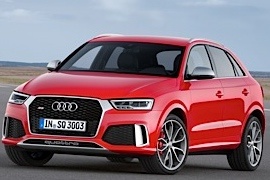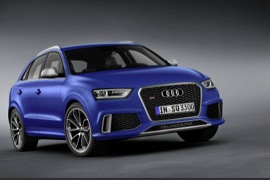AUDI RS Q3 Models/Series Timeline, Specifications & Photos
First production year: 2013
Engines: Gasoline
Body style: SUV (Sports Utility Vehicle)
Audi refreshed the RS Q3 lineup in 2015, and, besides the exterior and interior upgrades, it also boosted the engine's power and improved the transmission, so the small-sized SUV got sports-car performance, even though it wasn't one.
The Q3 was the third member of the Audi family to receive an RS treatment. Since it was based on the same platform as the A3, it wasn't difficult for the German automaker to install the same drivetrain as in the RS3. Still, that didn't happen when the model broke covers in 2013, and people complained about it. Two years later, the automaker improved the car and fixed all the things that customers wanted, boosting sales.
Unlike the rest of the Q3 lineup, the RS version was special. It wasn't just more powerful, but it also had to show it. As a result, the entire aerodynamic package of the car, the wheels, and the paint schemes were different. At the front, the car featured the single-frame grille specific for the brand but complemented by a chromed rim that surrounded it. In addition, the automaker added two side scoops adorned by a mesh with a hexagonal pattern finished in piano black. To further emphasize the car's sporty character, on the lower part of the bumper, there was a silver trim sporting the quattro lettering. Just like the rest of the RS family, the most powerful version of the Q3 featured silver door mirrors. From its profile, it revealed a similar shape to the rest of its stablemates, but on top of the raked-forward tailgate, the car manufacturer added a roof spoiler. Finally, at the back, the sporty crossover featured a diffuser placed under the bumper and a single oval exhaust.
Inside, the RS Q3 featured high-bolstered front seats adorned with the RS Q3 logo on their seatbacks. A low center console divided the driver from the side passenger and housed the gear selector and the controller for Audi's MMI infotainment system. The driver fronted a flat-bottom steering wheel and an instrument cluster filled with two large dials for the speedometer and tachometer that flanked a TFT display. In the back, just like on its predecessor, the 2016 RS Q3 featured a split-folding bench seat fit for three, although the tall transmission tunnel limited the legroom for a third, middle-seated occupant.
But the most significant changes happened under the hood. Audi installed a 2.5-liter turbocharged engine that was offered exclusively on RS-badged versions. It was an evolution of the same powerplant installed on the non-facelifted RS Q3 that was launched in 2013 and offered 30 more ponies for the German high-rider hatchback. In addition, the automaker installed a new and improved S-Tronic dual-clutch automatic gearbox that shortened the time for the gear changes. Moreover, the new wet-type system allowed the vehicle to launch better. Combined with the increased power and torque of the engine, the result was a lower 0-100 kph (0-92 MPH) time by 0.7 seconds, from 5.5 for the non-facelifted version to just 4.8 for the 2016 model year.
In 2013 Audi launched the first RS-badged Q model from its lineup, and customers were thrilled; their demands were heard.
The Rennsport division of the German automaker was responsible for creating the most potent vehicles that rolled out from Audi's assembly lines. So, when the first generation of the Q3 stormed the crossover market in 2011, many fans asked if there would be an RS version. But the automaker waited for two years before launching it. But when it did, it met the customers' expectations.
With a lowered ground clearance by 25 mm (1 inch) and standard 19” alloy wheels (on selected markets), the RS Q3 looked ready to tackle any kind of road, paved or unpaved. The front fascia sported the single-frame grille surrounded by a satin-chromed rim and a honeycomb mesh grille. On the lower bumper, the crossover featured side scoops that channeled air to the front brakes and a lower grille adorned with an aluminum-looking trim at the bottom. From its profile, the silver door mirrors and the roof spoiler mounted on top of the raked-forward tailgate enhanced the car's sporty look. Last but not least, a single oval exhaust peaked through the rear bumper.
The cabin boasted high-bolstered bucket seats and a flat-bottom steering wheel, signs that the RS Q3 was not just good for doing school runs. In addition, the infotainment system (MMI) offered more settings and features than other Audi models. Thanks to the quilted leather-wrapped interior with Alcantara inserts, customers could enjoy a luxurious experience as well as sporty.
Even though the 2012 RS Q3 concept car provided 360 PS (355 hp), the production version offered just 310 PS (306 hp), but customers didn't complain. After all, the car could sprint from naught to 62 mph (0-100 kph) in 5.5 seconds. The only transmission available was a seven-speed (dual-clutch) S-tronic gearbox that sent power in all corners via a Haldex center differential.

